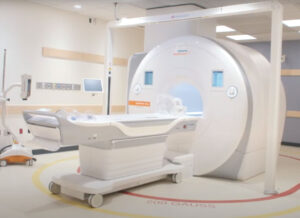
For many men diagnosed with early-stage, localized prostate cancer, external-beam radiation therapy offers the best chance of a cure. But this form of treatment is not without side effects. Furthermore, the number of scheduled treatments—as many as 44 over nine weeks—can be a major inconvenience that can adversely affect overall quality of life during treatment.
For select patients, Dana-Farber/Brigham and Women’s Cancer Center (DF/BWCC) is now offering stereotactic body radiotherapy (SBRT) on a magnetic resonance imaging-guided linear accelerator (MRI-LINAC).
“The MRI-LINAC is a versatile machine that allows us to treat tumors in many parts of the body in a safer and more effective manner,” said Jonathan E. Leeman, MD, a radiation oncologist at DF/BWCC.
DF/BWCC has been using the MRI-LINAC for prostate cancer and a number of other types of cancer, including pancreatic, liver and lung, since 2019. This technology is only available at a handful of centers in the United States, and DF/BWCC is the first in New England to offer this form of treatment.
Adaptive Planning Enables Customized Treatments
According to Dr. Leeman, the MRI-LINAC provides a number of benefits in terms of how radiation treatment is approached. One advantage is that it allows radiation oncologists and medical physicists to use MRI scans rather than CT scans for treatment planning. “MRIs give us a higher-quality image of the tumor as well as the surrounding tissues,” Dr. Leeman said.
Unlike standard radiation therapy, in which the patient undergoes a single planning scan before the start of a weeks-long course of therapy, the MRI-LINAC collects a new set of images before every treatment. This allows the medical team to do adaptive radiation planning, altering and perfecting the radiation plan based on what the anatomy looks like that particular day and any changes in the tumor.
“It may be that the tumor is shrinking, in which case we can target a smaller area,” Dr. Leeman said. “At other times, we may see that the area we’re treating is actually getting bigger due to either swelling or tumor growth in between treatments.”
Real-time imaging also helps to avoid unnecessary radiation exposure to critical internal organs, including the bladder and bowel. “By allowing us to develop a new, personalized plan each time, we have greater confidence that we’re treating the cancer precisely and accurately,” Dr. Leeman said.
Shorter Treatment Course Improves Quality of Life
Being able to precisely target the tumor while sparing surrounding tissue enables the usage of higher radiation doses. These higher doses mean the cancer can be eradicated with fewer treatments overall. Rather than 44 treatments with a standard course of radiation, or 20 to 30 treatments with a more condensed course, the MRI-LINAC allows treatment to be completed in only five sessions over a two-week period.
“As a result, patients can avoid the disruption and stress of daily treatment for so many weeks,” Dr. Leeman said. “And in the time of COVID-19, it’s especially important to minimize the number of visits.”
Other forms of SBRT may also employ this reduced number of doses, but Dr. Leeman said that the MRI-LINAC offers the additional advantages of adaptive planning and real-time, MRI-based target tracking.
Another difference is that MRI-LINAC treatment does not require the placement of markers for tracking tumor location. With other types of external-beam radiation, an invasive procedure is necessary before treatment to place these markers.
“That procedure can be associated with a lot of discomfort and carries risks that include bleeding and infection,” Dr. Leeman said. “Because treatment with the MRI-LINAC doesn’t require these markers, it is completely noninvasive.”
Very Low Rates of Side Effects Reported
Treatments with the MRI-LINAC have not been around long enough to assess long-term outcomes with regard to recurrence rates. However, Dr. Leeman said that so far, they appear to be at least on par with traditional forms of radiation treatment. Studies from other groups that have been using the device for longer have reported very low rates of side effects, particularly those related to the bowels, he added.
Dr. Leeman’s team is exploring how to alleviate the impact of radiation on the bladder, urethra and bowels as well as how to reduce problems with erectile dysfunction and sexual function caused by radiation damage to the nerves and blood vessels.
“We are continually looking at ways to improve all aspects of a patient’s quality of life after treatment,” Dr. Leeman concluded.